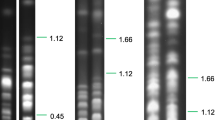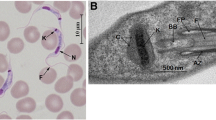Abstract
Calcineurin B, the regulatory subunit of calcineurin, a serine/threonine protein phosphatase, is highly conserved throughout the evolutionary scale including trypanosomatids such as Trypanosoma cruzi, and Leishmania major. Thus, in these flagellates the protein is required for mammalian host cell invasion and virulence and stress responses. With the aim of determining the presence of calcineurin B in Trypanosoma rangeli, a non-virulent trypanosome for mammals, the respective gene was amplified by PCR, cloned and sequenced. Two sequences of 531 bp in length showing a nucleotide polymorphism (314A>C) were obtained in spite of a single-copy gene was revealed by Southern blot. These sequences, probably the alleles from the gene, showed a 79 % of identity with those from T. cruzi and clustered as the sister group of this trypanosome species in a Maximum Parsimony analysis. Deduced amino acid sequence comparison with trypanosomatids and other organisms through the phylogenetic scale as well as the obtained protein structural homology model suggested the presence of the four potential EF-hand regions and the corresponding calcium binding sites of the last three of these domains. Having assessed the expression of this protein in T. rangeli epimastigotes, and taking into account the following facts: (i) calcineurin inhibitors have inhibitory effect on the in vitro replication of T. cruzi, (ii) L. major promastigote growth is inhibited by chelating agents, and (iii) T. rangeli does not seem to productively infect mammalian cells, it is hypothesized herein that the function of this protein in T. rangeli is required for epimastigote growth.





Similar content being viewed by others
References
Rusnak F, Mertz P (2000) Calcineurin: form and function. Physiol Rev 80:1483–1521
Stie J, Fox D (2008) Calcineurin regulation in fungi and beyond. Eukaryot Cell 7:177–186. doi:10.1128/EC.00326-07
Moreno SN, Silva J, Vercesi AE, Docampo R (1994) Cytosolic-free calcium elevation in Trypanosoma cruzi is required for cell invasion. J Exp Med 180:1535–1540. doi:10.1084/jem.180.4.1535
Andrade LO, Andrews NW (2005) The Trypanosoma cruzi-host-cell interplay: location, invasion, retention. Nat Rev Microbiol 3:819–823. doi:10.1038/nrmicro1249
Moreno VR, Aguero F, Tekiel V, Sanchez DO (2007) The calcineurin A homologue from Trypanosoma cruzi lacks two important regulatory domains. Acta Trop 101:80–89. doi:10.1016/j.actatropica.2006.11.008
Araya JE, Cornejo A, Orrego PR, Cordero EM, Cortéz M, Olivares H, Neira I, Sagua H, Da Silveira JF, Yoshida N, González J (2008) Calcineurin B of the human protozoan parasite Trypanosoma cruzi is involved in cell invasion. Microbes Infect 10:892–900. doi:10.1016/j.micinf.2008.05.003
Naderer T, Dandash O, McConville MJ (2011) Calcineurin is required for Leishmania major stress response pathways and for virulence in the mammalian host. Mol Microbiol 80:471–480. doi:10.1111/j.1365-2958.2011.07584.x
Cuba CA (1999) Revisión de los aspectos biológicos y diagnósticos del Trypanosoma (Herpetosoma) rangeli. Rev Soc Bras Med Trop 31:207–220
Grisard EC, Steindel M, Guarneri AA, Eger-Mangrich I, Campbell DA, Romanha AJ (1999) Characterization of Trypanosoma rangeli strains isolated in Central and South America: an overview. Mem Inst Oswaldo Cruz 94:203–209
Guhl F, Vallejo GA (2003) Trypanosoma (Herpetosoma) rangeli Tejera, 1920: an updated review. Mem Inst Oswaldo Cruz 98:435–442
Pavia PX, Thomas MC, López MC, Puerta CJ (2012) Molecular characterization of the short interspersed repetitive element SIRE in the six discrete typing units (DTUs) of Trypanosoma cruzi. Exp Parasitol 132(2):144–150. doi:10.1016/j.exppara.2012.06.007->
Puerta CJ, Sincero TC, Stoco PH, Cuervo CL, Grisard EC (2009) Comparative analysis of Trypanosoma rangeli histone H2A gene intergenic region with distinct intraspecific lineage markers. Vector Borne Zoonotic Dis 9(5):449–456. doi:10.1089/vbz.2008.0017
Puerta CJ, Urueña CP (2005) Prácticas de biología molecular. Pontificia Universidad Javeriana, Bogotá
Altschul SF, Boguski MS, Gish W, Wootton JC (1994) Issues in searching molecular sequence databases. Nat Genet 6:119–129. doi:10.1038/ng0294-119
Grisard EC, Stoco PH, Wagner G, Sincero TC, Rotava G, Rodrigues JB, Snoeijer CQ, Koerich LB, Sperandio MM, Bayer-Santos E, Fragoso SP, Goldenberg S, Triana O, Vallejo GA, Tyler KM, Dávila AM, Steindel M (2010) Transcriptomic analyses of the avirulent protozoan parasite Trypanosoma rangeli. Mol Biochem Parasitol 174:18–25. doi:10.1016/j.molbiopara.2010.06.008
Pearson WR, Lipman DJ (1988) Improved tools for biological sequence comparison. Proc Natl Acad Sci USA 85:2444–2448
Edgar RC (2004) MUSCLE: a multiple sequence alignment method with reduced time and space complexity. BMC Bioinformatics 5:113. doi:10.1186/1471-2105-5-113
Nei M, Kumar S (2000) Molecular evolution and phylogenetics. Oxford University Press, New York
Tamura K, Peterson D, Peterson N, Stecher G, Nei M, Kumar S (2011) MEGA5: molecular evolutionary genetics analysis using maximum likelihood, evolutionary distance, and maximum parsimony methods. Mol Biol Evol 10:2731–2739. doi:10.1093/molbev/msr121
Arnold K, Kiefer F, Kopp J, Battey JN, Podvinec M, Westbrook JD, Berman HM, Bordoli L, Schwede T (2009) The Protein Model Portal. J Struct Funct Genomics 10:1–8. doi: 10.1007/s10969-008-9048-5 http://www.proteinmodelportal.org/. Accessed 21 Feb 2012
Roy A, Kucukural A, Zhang Y (2010) I-TASSER: a unified platform for automated protein structure and function prediction. Nat Protoc 5:725–738. doi:10.1038/nprot.2010.5
Zhang Y (2008) I-TASSER server for protein 3D structure prediction. BMC Bioinformatics 9:40. doi:10.1186/1471-2105-9-40
Schultz J, Milpetz F, Bork P, Ponting CP (1998) SMART, a simple modular architecture research tool: identification of signaling domains. Proc Natl Acad Sci USA 95:5857–5864
Letunic I, Doerks T, Bork P (2012) SMART 7: recent updates to the protein domain annotation resource. Nucleic Acids Res 40 (Database issue):D302-5. Simple modular architecture research tool. doi: 10.1093/nar/gkr931 http://smart.embl-heidelberg.de/. Accessed 21 Feb 2012
Bordoli L, Kiefer F, Arnold K, Benkert P, Battey J, Schwede T (2009) Protein structure homology modeling using SWISS-MODEL workspace. Nat Protoc 4:1–13. ExPASy bioinformatics resource portal doi:10.1038/nprot.2008.197 http://swissmodel.expasy.org/workspace/. Accessed 21 Feb 2012
Arnold K, Bordoli L, Kopp J, Schwede T (2006) The SWISS-MODEL workspace: a web-based environment for protein structure homology modelling. Bioinformatics 22:195–201. doi:10.1093/bioinformatics/bti770
Wiederstein M, Sippl MJ (2007) ProSA-web: interactive web service for the recognition of errors in three-dimensional structures of proteins. Nucleic Acids Res 35(Web Server issue):W407-10. Protein structure analysis ProSA-Web. doi: 10.1093/nar/gkm290 http://prosa.services.came.sbg.ac.at/prosa.php. Accessed 21 Feb 2012
Sippl MJ (1993) Recognition of errors in three-dimensional structures of proteins. Proteins 17:355–362
McGuffin LJ, Roche DB (2010) Rapid model quality assessment for protein structure predictions using the comparison of multiple models without structural alignments. Bioinformatics 26:182–188. doi:10.1093/bioinformatics/btp629
Guex N, Peitsch MC (1997) SWISS-MODEL and the Swiss-PdbViewer: an environment for comparative protein modeling. Electrophoresis 18:2714–2723. ExPASy bioinformatics resource portal web. http://www.expasy.org/spdbv/. Accessed 21 Feb 2012
Humphrey W, Dalke A, Schulten K (1996) VMD: visual molecular dynamics. J Mol Graph 14: 33–38. Theoretical and computational biophysics group web. http://www.ks.uiuc.edu/Research/vmd/. Accessed 21 Feb 2012
Steinbach WJ, Reedy JL, Cramer RA Jr, Perfect JR, Heitman J (2007) Harnessing calcineurin as a novel anti-infective agent against invasive fungal infections. Nat Rev Microbiol 5:418–430. doi:10.1038/nrmicro1680
Cuervo C, López MC, Puerta C (2006) The Trypanosoma rangeli histone H2A gene sequence serves as a differential marker for KP1 strains. Infect Genet Evol 6:401–409. doi:10.1016/j.meegid.2006.01.005
Diez H, Thomas MC, Urueña CP, Santander SP, Cuervo CL, López MC, Puerta CJ (2005) Molecular characterization of the kinetoplastid membrane protein-11 genes from the parasite Trypanosoma rangeli. Parasitology 130(Pt 6):643–651. doi:10.1017/S0031182004006936
Urrea DA, Carranza JC, Cuba Cuba CA, Gurgel-Gonc Alves R, Guhl F, Schofield CJ, Triana O, Vallejo GA (2005) Molecular characterisation of Trypanosoma rangeli strains isolated from Rhodnius ecuadoriensis in Peru, R. colombiensis in Colombia and R. pallescens in Panamá, supports a co-evolutionary association between parasites and vectors. Infect Genet Evol 5:123–129. doi:10.1016/j.meegid.2004.07.005
Urrea DA, Guhl F, Herrera CP, Falla A, Carranza JC, Cuba-Cuba C, Triana-Chávez O, Grisard EC, Vallejo GA (2011) Sequence analysis of the spliced-leader intergenic region (SL-IR) and random amplified polymorphic DNA (RAPD) of Trypanosoma rangeli strains isolated from Rhodnius ecuadoriensis, R. colombiensis, R. pallescens and R. prolixus suggests a degree of co-evolution between parasites and vectors. Acta Trop 120:59–66. doi:10.1016/j.actatropica.2011.05.016
Deschamps P, Lara E, Marande W, López-García P, Ekelund F, Moreira D (2011) Phylogenomic analysis of kinetoplastids supports that trypanosomatids arose from within bodonids. Mol Biol Evol 28:53–58. doi:10.1093/molbev/msq289
Nocua P, Gómez C, Cuervo C, Puerta C (2009) Cl gene cluster encoding several small nucleolar RNAs: a comparison amongst trypanosomatids. Mem Inst Oswaldo Cruz 104:473–480. doi:10.1590/S0074-02762009000300013
Barton N, Briggs D, Eisen J, Goldstein D, Patel N (2007) Species and speciation. In: Evolution, Cold Spring Harbor Laboratory Press, New York, pp 619–656
Maurer-Stroh S, Eisenhaber B, Eisenhaber F (2002) N-terminal N-myristoylation of proteins: prediction of substrate proteins from amino acid sequence. J Mol Biol 317:541–557. doi:10.1006/jmbi.2002.5426
Price HP, Menon MR, Panethymitaki C, Goulding D, McKean PG, Smith DF (2003) Myristoyl-CoA:protein N-myristoyltransferase, an essential enzyme and potential drug target in kinetoplastid parasites. J Biol Chem 278:7206–7214. doi:10.1074/jbc.M211391200
Búa J, Ruiz AM, Potenza M, Fichera LE (2004) In vitro anti-parasitic activity of cyclosporin A analogs on Trypanosoma cruzi. Bioorg Med Chem Lett 14:4633–4637. doi:10.1016/j.bmcl.2004.07.003
Eger-Mangrich I, de Oliveira MA, Grisard EC, De Souza W, Steindel M (2001) Interaction of Trypanosoma rangeli Tejera, 1920 with different cell lines in vitro. Parasitol Res 87:505–509. doi:10.1007/s004360000356
Acknowledgments
This work was financially supported by Colciencias Research project No. RC-595-2009. CAB and MM, were supported by the program Jóvenes Investigadores e Innovadores 2010 and 2011 from Colciencias. MC López and MC Thomas, were supported by Grants P08-CVI-04037 from PAI (Junta de Andalucía), BFU2010-1670 and SAF2012-35777 from Plan Nacional I+D+i (MICINN) and RD12/008/0021 from ISCIII-RETIC (MICINN), Spain and FEDER.
Author information
Authors and Affiliations
Corresponding author
Electronic supplementary material
Below is the link to the electronic supplementary material.
Rights and permissions
About this article
Cite this article
Montenegro, M., Cardenas, C., Cuervo, C. et al. Molecular characterization of calcineurin B from the non-virulent Trypanosoma rangeli kinetoplastid indicates high gene conservation. Mol Biol Rep 40, 4901–4912 (2013). https://doi.org/10.1007/s11033-013-2590-7
Received:
Accepted:
Published:
Issue Date:
DOI: https://doi.org/10.1007/s11033-013-2590-7




